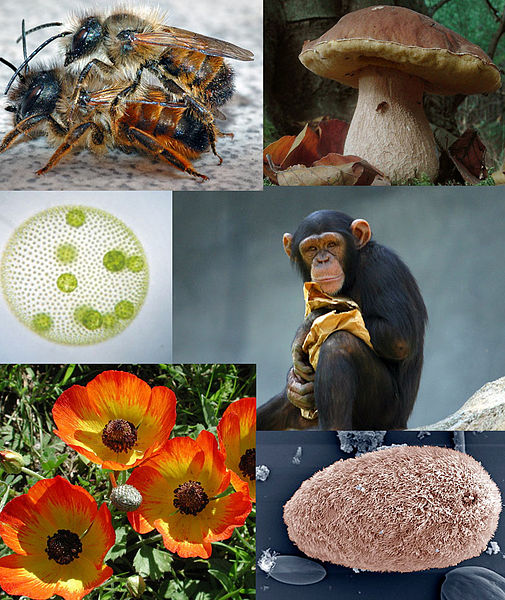Classification
 Domain-Eurkarya
Domain-Eurkarya
What defines an organism of the domain Eukarya? It’s really
rather simple. The members of the domain Eukarya must have
cells which MUST contain a nucleus and other organelles bound inside
of a membranous structure. The Wunderpus photogenicus
easily fits into this with its membranous cells (Tree 2014).
Kingdom-Animalia
Organisms of the kingdom, Animalia, are multicellular and
eukaryotic. Other distinguishing features of organisms of the
Animalia kingdom include being heterotrophic, or needing to consume
other organisms for energy, as well as being motile. Again
this is a very broad generalization that encompasses the
Wunderpus. Wunderpus is both
heterotrophic and motile with its tentancles (Tree 2014).
Phylum – Mollusca
Organisms of the phylum, Mollusca, are defined by three
characterizing features. The first feature is the inclusion of
a mantle. The mantle of a mollusk forms a sort of wall around
the body to keep contained the organism’s organs. The second
feature that characterizes a mollusk is having radula. The
radula of a mollusk is the part of their body for eating. The
final feature of a mollusk is the development of a nervous system.
The Wunderpus continues to fit this description with its
mantle being its bulbous head that carries its organs, the radula
situated at the base of the mantle for eating and its own nervous
system. This phylum also includes organism like
Pomatiopsis lapidaria (Tree 2014).
Figure 1. Evolutionary tree depicting the phylum Mollusca's evolution to its various classes. Wunderpus photogenicus belongs to the class Cephalopoda, which is most closetly related to the class Scaphopoda.
Class – Cephalopoda
For an organism to be classified into the class, Cephalopoda, they
must first and foremost be a marine organism. Other
distinguishing characteriscs of cephalopods include having bilateral
symmetry, or essentially if you were to cut the animal in half it
would be identical on both sides. A cephalopod will also have
a noticeable head and not to mention one of the most distinguishing
characteristics of the arms or “tentacles.” Now at this point
we are starting to move toward a more specific organism that the
Wunderpus continues to resemble. It lives in the Indian
Ocean and has bilateral symmetry. It's head is very noticable
and it has those unique tentacles (Tree 2014).
Order – Octopoda
Moving now to the order of Octopoda, these organisms are classified
by their distinct eight tentacles with “suckers.” Members of
the order Octopoda also have no shell, unlike many other orders
branching from Cephalopoda. The suborders of Octopoda, Cirrata
and and Incirrata, are distinguished by a pairing of fins on the
mantle of the Cirrata whereas the Incirrata are unfinned.
 With
its eight tentacles and suckers on each tentacle the Wunderpus
photogenicus continues its path along this taxonomic
classification (Tree 2014).
With
its eight tentacles and suckers on each tentacle the Wunderpus
photogenicus continues its path along this taxonomic
classification (Tree 2014).
Family – Octopodidae
Branching from Octopoda is the family, Octopodidae. What makes
the Octopodidae unique is the alignment of suckers on each tentacle.
They tend to run in either a single or double row. In the
males of this family one of their arms has evolved into a “sperm
groove” for
depositing sperm into the female of the species.
This family also has the inclusion of a beak and teeth! The
most well known of this family would be the common octopus or
Octopus vulgaris plus not to mention our very own
Wunderpus whose suckers run in a double row(Tree 2014).
Figure 2. Evolutionary tree depicting the family Octopodidae's evolution towards Genus and Species, including Wunderpus photogenicus. Wunderpus photogenicus is most closely related to Thamoctopus mimicus.
Genus – Wunderpus
Currently the Wunderpus photogenicus is the only member of the
genus, Wunderpus (Hochberg et al., 2006).
Species –
Wunderpus photogenicus
We can’t spoil all the fun for you here! You came to this
website to learn more about this marvelous creature. What I
can tell you is that Wunderpus translates to 'wonderful or
marvelous foot' and photogenicus refers to the high demand
of photographs people desire of this beautiful creature (Hochberg et
al., 2006). Now that
you have the basis for what defines this organism, it is time for you
to explore this website and learn as much as you can!
Go to the next page to learn about Habitat.
Go back to the Home page.

